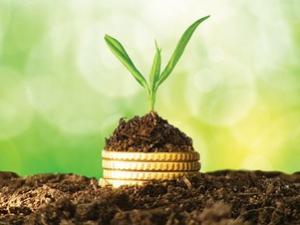Impact Investing and Saving: Planting Your Dollar
Submitted by Joel on | Updated Sat, 17/09/2016 - 23:49

Let’s start this article off with an overview of a trend that has recently been on my mind: impact investing.
First, what is it?
The traditional role of investment hasn’t changed here. Investments are intended to preserve and grow capital. However, other goals are introduced when investing in companies with environmentally and socially progressive policies and products. Investors shift their assessments from only monetary performance to a broader perspective termed the Triple Bottom Line,.
Trends suggest that young people are increasingly searching for alternatives to traditional banking and investment. Research shows that millennials are “nearly twice as likely as the overall investor population to make investments where the aim of the company or fund is to make a positive social or environmental impact”1 and nearly 70% of them “view investment decisions as a way to express social, political or environmental values.”2
In sync with this trend, the divestment movement has also caught fire. Over 220 institutions around the world had committed to some form of divestment as of mid-20153. There are two arguments for divestment, the first being moral and the second financial. The financial argument “rests on the premise that if international agreements on climate change are met, the investments will become worthless”3.
You might question what kind of impact can really be made by an individual when comparing their finances to the billions of dollars corporations have at their disposal. Simply put, the dollars that individuals have both divested and invested send a message to corporations by affecting demand and putting additional emphasis on what the public values. As shown below, that number is substantial and steadily growing.4
What to do, and what’s your impact?
Readers will find themselves in one of numerous financial situations. You might be paying down student debt, saving for a home or a car, planning for retirement, or you might be unsure what to do with your savings each month. Regardless of your category, if you are putting aside any of your hard earned cash into mutual funds, TFSA’s, RSP’s, etc., you do have the opportunity to put your dollars to work in a green economy. The options for green and social investing are far greater than they have been in the past, though at this stage finding them still takes some extra effort.
Here are some first steps and their associated impact:
-
Contact an advisor at your bank or pension fund.
The major banks and funds in Canada are just arriving to the party, so not everyone will have the opportunity with their current institution or portfolio. Whether you are just starting or are already a savvy investor, the first step is to ask!
Asking sends a message to your institution that the demand for green investments exists. Be clear what your goals are so they can help you determine an investment strategy. I’ve listed some options here:
-
TD launched a green-bond in 2014. Ask your TD advisor about it or any alternatives.
-
RBC launched a social finance initiative in 2014. Ask your RBC advisor about it.
-
BMO can help you go green too, as of 2015. Ask, ask, ask.
-
CIBC is also a clean tech financer. Ask a CIBC advisor if you can get involved.
-
Scotiabank has a climate change fund. Again, ask!
Your impact per dollar here is tough to measure because your investment supports a portfolio of companies that are not necessarily using your money directly for energy savings or renewable power production. However, you will know that these companies have been chosen for their sustainable business practices and environmental conscience.
-
Consider alternative investment options.
Making an investment outside of your traditional institution can take a lot of research and work. It can also be difficult to get your foot in the door without substantial capital. Here are a couple accessible options I found:
-
I just signed up for the newsletter at CoPower – a crowd sourcing platform like Kiva or KickStarter, but for green investment. They aim to reduce the minimum amount of investment to make green investing more accessible. They are launching a green-bond this February!
-
For those who can’t get solar on their own roof, Solar Share lets you get involved at a low minimum investment.
Measuring your impact in this scenario is easier! Depending on what sector you invest in, your dollars will make a direct contribution to technologies that are up to 15 times less carbon intensive than traditional power generation over their lifetime.
-
Stay with me for the next section of this article. It’s short.
WYI’s “Use Less Electricity” section is full of good ideas for reducing your own impact. I want to convince you that doing so is also a savvy investment.
Impact saving.
I believe the rule that spending now on purchases that save money later is considered an investment. In fact, these expenditures are a low risk investment. If you spend wisely on energy saving devices, you are, in essence, impact investing.
Bob McDonald of CBC’s “Quirks and Quarks” argues that going green makes money: “It’s already been demonstrated at the simplest level, with examples such as hotels that have installed low-flush toilets and efficient shower heads, and then recouped those costs through savings in a very short time.”5
I’m certain that if you could be guaranteed a 10% yearly return on investment, you’d be quite happy with your bank. Now consider that buying LED lighting can pay itself back within two years. That’s a 50% return. Heating and cooling likely makes up the largest part of your bill, and replacing an old furnace often has about a ten year payback period (even with financing) – that’s a 10% return on your dollar. These purchases also add value to your home.
Renting? Call your landlord. I’m serious.
There are plenty of other ways to save energy and money. Take a minute to review some recent articles on from WYI you may have missed!
Heating your home.
Lighting.
Laundry.
Unplugging.
I hope this brief article encourages you to become an early adopter of impact investing. Join the growing first wave of individuals making their money make a difference.
Works Cited:
1. https://copower.me/en/news/will-millennials-take-impact-investing-mainstream/
2. http://socialfinance.ca/2015/11/05/copower-why-and-how-we-are-simplifying-green-investing/
3. http://www.theguardian.com/environment/2015/jun/23/a-beginners-guide-to-fossil-fuel-divestment
4. http://socialfinance.ca/2015/07/17/6-2-trillion-green-investments-matter-global-economy/
Images from:
https://pbs.twimg.com/media/CZRecC9W0AET5yZ.jpg
http://ggs-greenhouse.com/blog/energy-savings-your-greenhouse
You will save the Earth by sharing and/or tweeting (corny right?)





